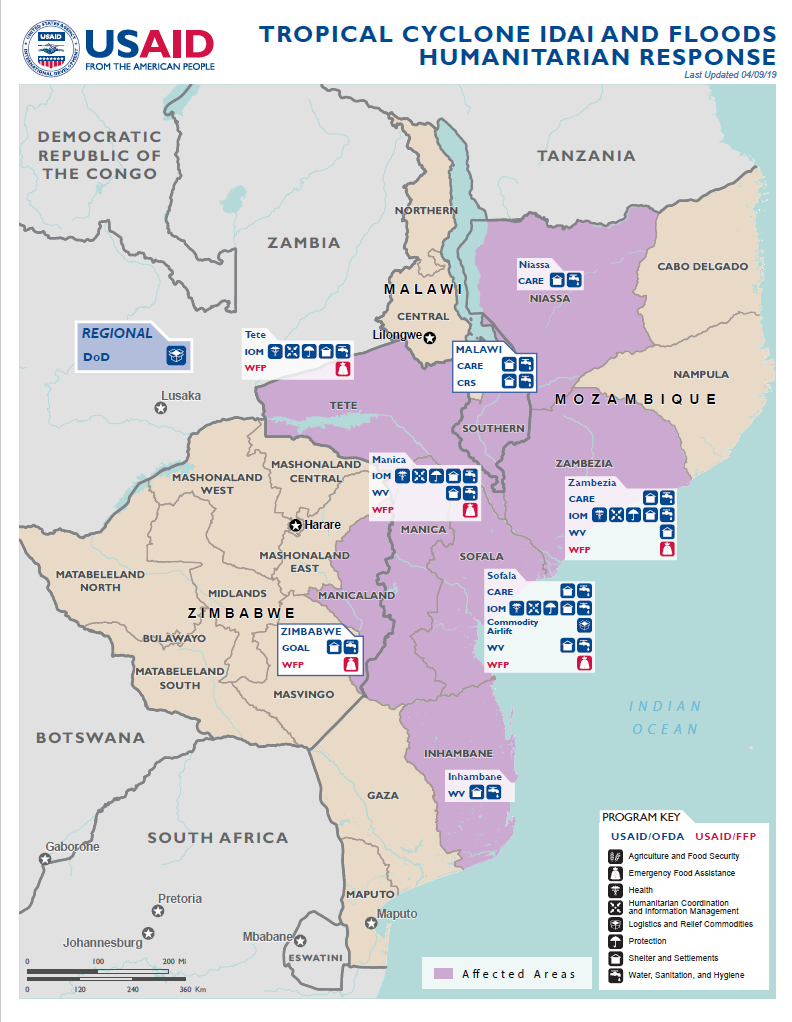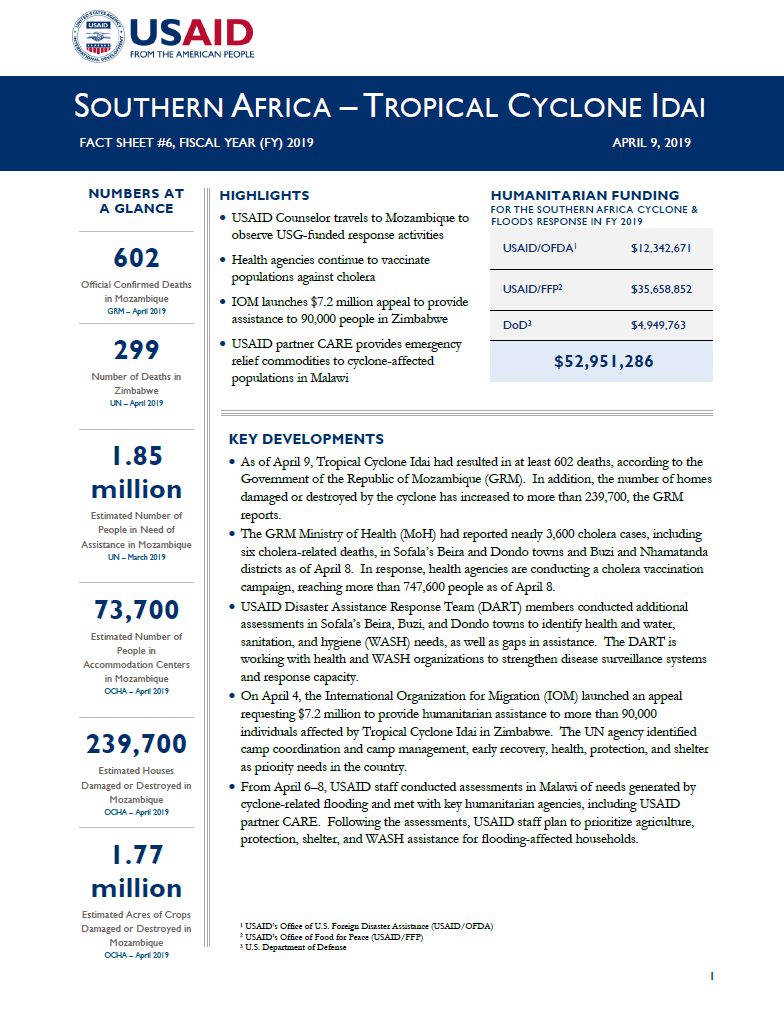Speeches Shim
April 9, 2019
Numbers At A Glance
602
299
1.85 million
73,700
239,700
1.77 million
Humanitarian Funding
FOR THE SOUTHERN AFRICA CYCLONE & FLOODS RESPONSE IN FY 2019
| USAID/FFP | $35,658,852 |
| USAID/OFDA | $12,342,671 |
| DoD | $4,949,763 |
| TOTAL | $52,951,286 |
Highlights
- USAID Counselor travels to Mozambique to observe USG-funded response activities
- Health agencies continue to vaccinate populations against cholera
- IOM launches $7.2 million appeal to provide assistance to 90,000 people in Zimbabwe
- USAID partner CARE provides emergency relief commodities to cyclone-affected populations in Malawi
Key Developments
As of April 9, Tropical Cyclone Idai had resulted in at least 602 deaths, according to the Government of the Republic of Mozambique (GRM). In addition, the number of homes damaged or destroyed by the cyclone has increased to more than 239,700, the GRM reports.
The GRM Ministry of Health (MoH) had reported nearly 3,600 cholera cases, including six cholera-related deaths, in Sofala’s Beira and Dondo towns and Buzi and Nhamatanda districts as of April 8. In response, health agencies are conducting a cholera vaccination campaign, reaching more than 747,600 people as of April 8.
USAID Disaster Assistance Response Team (DART) members conducted additional assessments in Sofala’s Beira, Buzi, and Dondo towns to identify health and water, sanitation, and hygiene (WASH) needs, as well as gaps in assistance. The DART is working with health and WASH organizations to strengthen disease surveillance systems and response capacity.
On April 4, the International Organization for Migration (IOM) launched an appeal requesting $7.2 million to provide humanitarian assistance to more than 90,000 individuals affected by Tropical Cyclone Idai in Zimbabwe. The UN agency identified camp coordination and camp management, early recovery, health, protection, and shelter as priority needs in the country.
From April 6–8, USAID staff conducted assessments in Malawi of needs generated by cyclone-related flooding and met with key humanitarian agencies, including USAID partner CARE. Following the assessments, USAID staff plan to prioritize agriculture, protection, shelter, and WASH assistance for flooding-affected households.
MOZAMBIQUE
Current Situation
As access to affected areas continues to improve, the GRM and relief agencies are able to conduct additional damage assessments and verify humanitarian needs. The official number of confirmed deaths related to Tropical Cyclone Idai in Mozambique had increased to 602, while the number of homes damaged or destroyed had increased to more than 239,700 as of April 9, according to the GRM. The estimated acreage of damaged or destroyed agricultural land remained constant at 1.77 million acres; however, the number of crops, livestock, and fisheries affected is expected to rise as relief agencies determine the full extent of the cyclone’s damage.
Humanitarian Response and Gaps
From April 4–8, the GRM reported nearly 1,500 new cholera cases, bringing the total number of reported cholera cases to nearly 3,600 and six cholera-related deaths. Health agencies—led by the UN Children’s Fund (UNICEF) and the UN World Health Organization (WHO)—continue to conduct a cholera vaccination campaign and had reached more than 747,600 individuals as of April 8. The DART is supporting health organizations and WASH in identifying gaps in the cholera response, particularly in WASH assistance and community engagement, and recently helped to refine the WASH cholera response strategy.
The WASH Cluster is considering market-based interventions to allow beneficiaries to purchase items such as buckets, soap, sanitary pads, and water containers, following a market capacity assessment. The national water supply agency is also working to estimate the coverage of its water distribution network in each barrio, or neighborhood, to enable relief agencies to more appropriately target distributions of Certeza—a water treatment agent—and other cholera-related interventions.
The Camp Coordination and Camp Management (CCCM) Cluster, in coordination with the GRM, is supporting the creation of several consolidated sites in areas outside of Beira to relocate populations from accommodation centers located in schools and health facilities. The UN, the CCCM Cluster, and other relief agencies are engaging in advocacy to ensure that relocations are safe, voluntary, and dignified.
As access has improved due to receding floodwaters and relief agencies have been able to transport sufficient relief supplies to affected areas, the Logistics Cluster has noted a decrease in demand for transportation assistance from the capital city of Maputo. As a result, the Logistics Cluster announced that chartered air operations from Maputo to Beira and Chimoio will end by April 12, and the UN Humanitarian Air Service intends to scale down air operations from Maputo to affected areas in the coming days.
USG ASSESSMENTS AND RESPONSE
On April 6, USAID Counselor Chris Milligan traveled to Beira to meet with GRM, UN, and non-governmental organization representatives involved in the response to the cyclone. Counselor Milligan also accompanied UN World Food Program (WFP) personnel on a food distribution in Sofala’s Bandua town and observed the arrival of USAID food and nutrition commodities at the airport in Beira.
On April 6, DART members conducted a rapid assessment of living conditions in Beira. Although community members did not report a notable increase in illness, DART staff noted that the healthcare facility in the town maintained an inadequate supply of medications and supplies, especially anti-malarial medications. The DART also met with representatives of two national water regulatory agencies in Beira to develop a water quality monitoring plan for Sofala’s Beira and Dondo towns on April 5. The team helped establish a plan for monitoring residual chlorine—to test whether water has been appropriately treated—at key water points in the municipal water supply network, including public taps, hospitals, and schools, as well as water trucking sources and water points at accommodation centers.
WFP is piloting a voucher program in Beira to allow cyclone-affected individuals to access food through local markets, rather than relying on in-kind food assistance. WFP hopes to scale up the program—endorsed by the GRM—to reach at least 50 percent of the targeted 1,000 households within 90 days, assuming that market conditions remain stable.
ZIMBABWE
Current Situation
While authorities are reopening some roads and bridges damaged by Tropical Cyclone Idai in Zimbabwe’s Chipinge and Chimanimani districts, several areas in the districts—including Chimanimani’s Nyahode town—remain difficult to access. The Logistics Cluster continues to deliver relief commodities by helicopter to nine landing zones across Chimanimani and has transported nearly 30 metric tons (MT) of relief commodities on behalf of humanitarian organizations to date.
On April 4, IOM launched an appeal requesting $7.2 million to provide humanitarian assistance to more than 90,000 individuals in response to the effects of Tropical Cyclone Idai in Zimbabwe. The UN agency identified camp coordination and camp management, early recovery, health, protection, and shelter as priority needs in the country. In addition, IOM is assessing needs and tracking mobility across Buhera, Chipinge, Chimanimani, and Mutare districts to inform its Displacement Tracking Matrix, which many humanitarian organizations utilize when planning relief operations.
MALAWI
Current Situation
Relief organizations had provided multi-sector humanitarian assistance—including health, nutrition, protection, shelter, and WASH services—to 90,000 households affected by Tropical Cyclone Idai as of April 7, according to the Government of Malawi Department of Disaster Management Affairs (DoDMA). The agency also estimates that 5 percent of the total affected population, or approximately 43,400 people, have yet to receive assistance as they are located in hard-to-reach areas. Humanitarian agencies are coordinating with DoDMA to reach isolated locations. The Humanitarian Country Team noted that, while many partners have contributed support across Malawi, additional coordination is required at the district level to ensure the smooth delivery of assistance to affected areas.
As of April 7, international donors had provided approximately $19.6 million, or 43 percent of the $45.2 million requested in the DoDMA Flood Response Plan launched on March 28. The African Union (AU) provided Malawi with $100,000 to assist with recovery efforts following an assessment delegation led AU Sub-Committee on Refugees, Returnees and Displaced Persons Chairperson Lamine Baali. In addition, on April 3 the Government of the People’s Republic of China contributed $300,000 alongside more than 6,000 MT of rice to Malawi in response to the needs generated by flooding.
USG Response and Assessments
On April 6, USAID staff met with DoDMA officials to discuss response progress and challenges. Primary challenges include coordination and information management, standardizing packages of food and relief items, and limited resources, according to DoDMA. The USAID team also met with UN Food and Agriculture Organization staff, who noted that more than 148,000 acres of crops have been damaged as a result of the flooding. Food and agriculture organizations plan to provide inputs for winter cropping and support to government extension services in the coming weeks. After conducting assessments, USAID staff plan to prioritize agriculture, shelter, and WASH assistance and highlight protection as a cross-cutting priority.
USAID partner CARE had distributed 6,000 buckets and 3,000 water purification products to several displacement sites in Nsanje District, in addition to plastic sheeting to an estimated 2,000 households, as of April 8. CARE is also coordinating with the district council to prepare for the April–May planting season and provide seeds to approximately 3,000 households.
CONTEXT
Tropical Cyclone Idai made landfall over Mozambique’s city of Beira, Sofala Province, on March 15, producing torrential rains and strong winds and severely affecting Manica, Sofala, Tete, and Zambézia provinces. The cyclone also caused significant flooding, damage and destruction of property and infrastructure, and resulted in numerous deaths in southern Malawi’s Chichawa, Nsanje, Phalombe, and Zomba districts and Zimbabwe’s Manicaland Province. The same weather system had previously brought heavy rains that caused significant flooding in Malawi and Mozambique in early March, before gaining strength in the Mozambique Channel and evolving into a tropical cyclone.
On March 10, U.S. Ambassador to Malawi Virginia E. Palmer declared a disaster due to the effects of floods in Malawi. In response USAID/OFDA provided an initial $200,000 to CARE and Catholic Relief Services. On March 15, U.S. Ambassador to Mozambique Dennis W. Hearne declared a disaster due to the effects of floods in Mozambique. Ambassador Hearne declared a second disaster on March 19 due to the impact of Tropical Cyclone Idai in Mozambique. In response, USAID/OFDA provided $200,000 to CARE to procure emergency relief commodities and support shelter and WASH interventions. USAID/OFDA also provided $200,000 to World Vision to response to immediate WASH and shelter needs. On March 18, U.S. Ambassador to Zimbabwe Brian A. Nichols declared a disaster due to the impact of Tropical Cyclone Idai. In response USAID/OFDA provided an initial $100,000 to GOAL to procure emergency relief commodities and support shelter and water, sanitation, and hygiene interventions.
On March 20, USAID deployed a DART to lead the USG response to Tropical Cyclone Idai in Mozambique. USAID also activated a Washington, D.C.-based Response Management Team (RMT) to support the DART. The DART and RMT are responding to the situation in coordination with other USG counterparts, GoM representatives, and humanitarian partners.
PUBLIC DONATION INFORMATION
The most effective way people can assist relief efforts is by making cash contributions to humanitarian organizations that are conducting relief operations. A list of humanitarian organizations that are accepting cash donations for disaster responses around the world can be found at www.interaction.org.
USAID encourages cash donations because they allow aid professionals to procure the exact items needed (often in the affected region); reduce the burden on scarce resources (such as transportation routes, staff time, and warehouse space); can be transferred very quickly and without transportation costs; support the economy of the disaster-stricken region; and ensure culturally, dietarily, and environmentally appropriate assistance.
More information can be found at:
- USAID Center for International Disaster Information: www.cidi.org or +1.202.661.7710.
- Information on relief activities of the humanitarian community can be found at www.reliefweb.int.



Comment
Make a general inquiry or suggest an improvement.